Solar Market Insight Report 2018 Year In Review
Other Links: Purchase the Full Report | Press Release
The quarterly SEIA/Wood Mackenzie Power & Renewables U.S. Solar Market InsightTM report shows the major trends in the U.S. solar industry. Learn more about the U.S. Solar Market Insight Report. Released March 13, 2019
Key Figures
- In Q4 2018, the U.S. solar market installed 4.2 GWdc of solar PV, a 139% increase from Q3 2018 and a 4% increase from Q4 2017. This brought the annual total to 10.6 GWdc, 2% lower than 2017.
- For the sixth straight year, solar was one of the top two sources of new electricity generating capacity in the U.S.
- Cumulative operating solar photovoltaic capacity now stands at 62.4 GWdc, about 75 times more than was installed at the end of 2008.
- After a year in which residential solar experienced 15% contraction, 2018 marked a year of rebound as the market grew by 7%. Q4 was the largest quarter for the residential solar segment in two years, a sign that the residential market is stabilizing. In total, 314,600 new residential PV systems were installed in 2018.
- Non-residential PV saw an annual decline of 8%, mainly due to policy shifts in states like California and Massachusetts.
- There were 6.2 GWdc of utility solar installed in 2018, accounting for 58% of total U.S. annual capacity additions.
- After the uncertainty of the Section 201 tariffs passed, 13.2 GWdc of utility solar PPAs were signed in 2018, though mostly with expected commercial operations dates in years after the tariffs have stepped down. The contracted pipeline peaked in Q3 2018 at 25.3 GWdc, the highest in the history of U.S. solar.
- Wood Mackenzie forecasts 14% growth in 2019 compared to 2018, with over 12 GW of installations expected.
- Total installed U.S. PV capacity will more than double over the next five years, with annual installations reaching 15.8 GWdc in 2021 prior to the expiration of the residential federal Investment Tax Credit (ITC) and a drop in the commercial tax credit to 10% for projects not yet under construction.
1. Introduction
In 2018, the U.S. solar market installed 10.6 gigawatts direct current (GWdc) of solar photovoltaic (PV) capacity, a 2% decline from capacity additions in 2017. After a year in which the residential sector experienced 15% contraction, 2018 marked a year of rebound as the residential market grew by 7%. Conversely, non-residential PV saw a slight annual decline of 8%. Utility solar also saw slight annual contraction, due to the impacts of Section 201 tariff uncertainty earlier in the year and shifting project timelines based on the tariff schedule. Overall, in 2018, solar PV has accounted for 29% of new electricity generating capacity additions – a lower share compared to 2017 due to a surge in new natural-gas plants in early 2018.
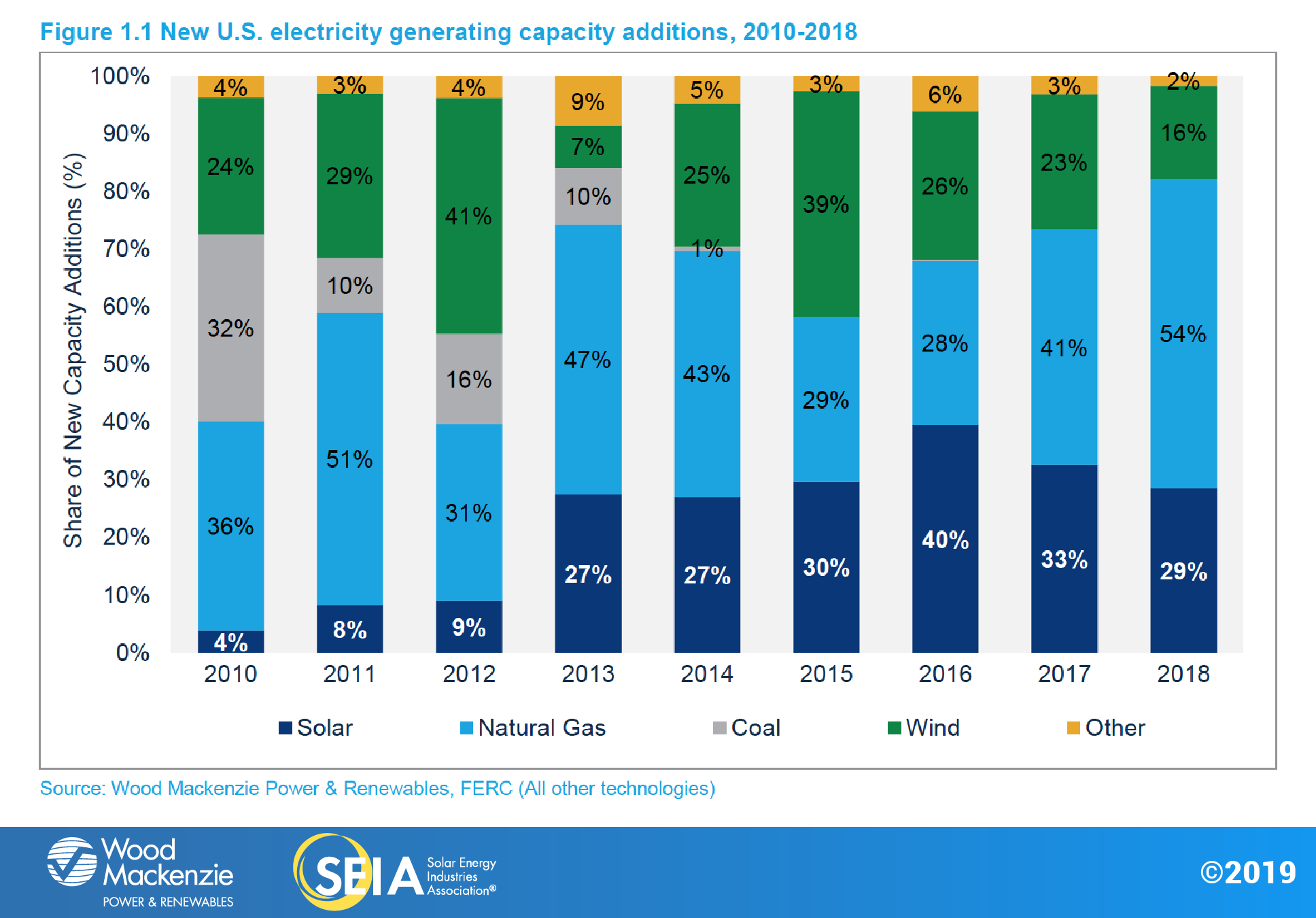
Residential PV rebounded in 2018 as the market begins to reach maturity
After experiencing volume contraction last year, the residential solar market regained its footing in 2018 with steadily increasing installation volumes. The fourth quarter of 2018 was the largest quarter for the residential segment in two years. Five quarters of modest growth now suggest the market is adopting a more sustainable growth profile with a mix of local and regional installers operating alongside national installers.
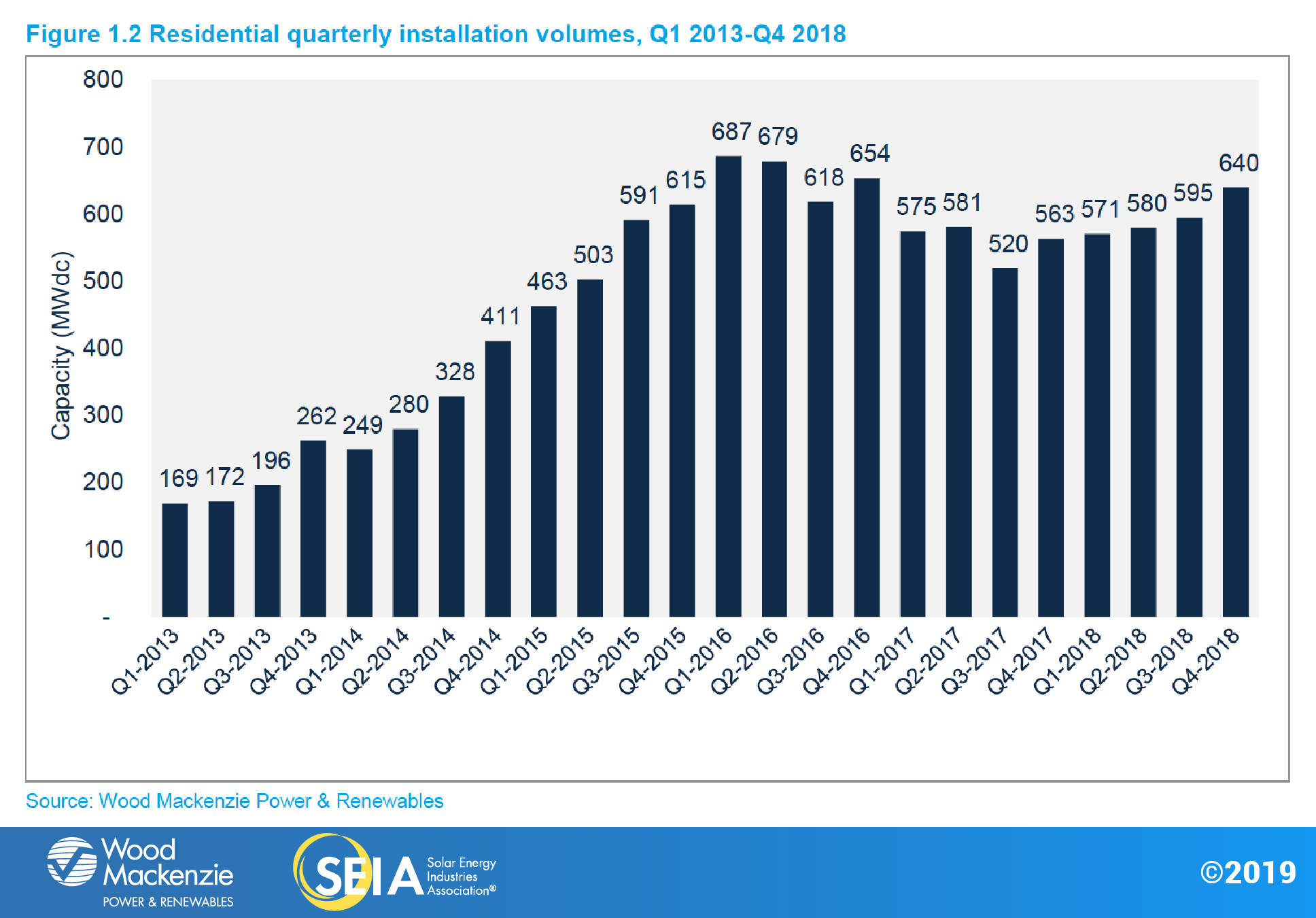
With 2018 in the books, a few key themes have emerged about the state of the residential solar market.
Installation growth and market penetration levels suggest major states have moved past early adopters. Among the highest-penetration markets in the nation, residential growth rates were mixed in 2018. The one exception to this was Nevada, which experienced 3x growth once net metering was reinstated in 2017 after being revoked in 2016, which caused the market to contract by 61% from 2016 to 2017.This political turmoil led to abnormally high installations in 2018 based on pent-up demand. Outside the stabilizing large markets, growth in low-penetration emerging markets, such as Texas and Florida, continues to add to the geographic diversity of the residential market outside of California and the Northeast.
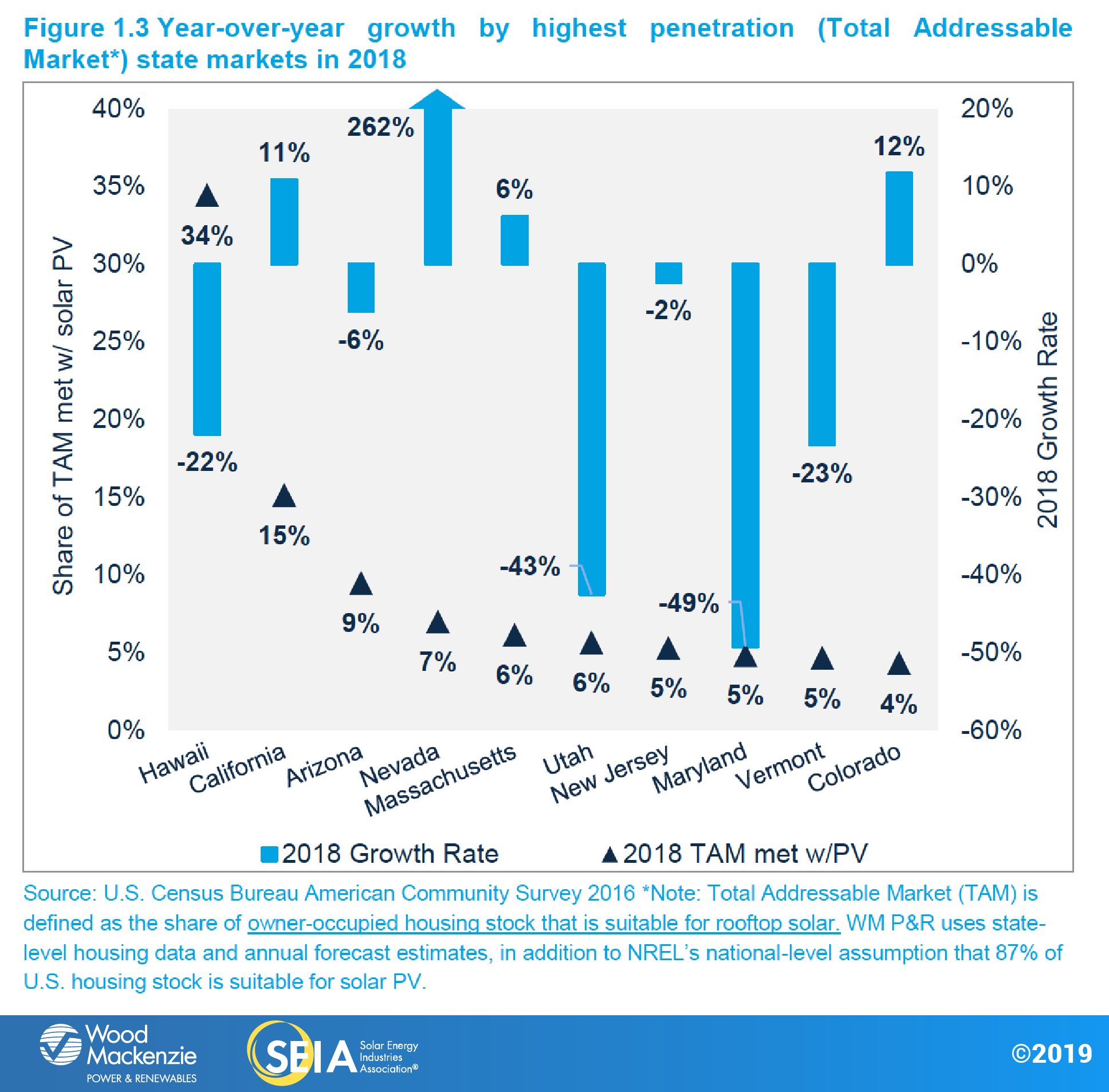
Legacy markets are no longer the primary engines of growth. Though California is forecasted to be the largest market for the foreseeable future due to the sheer size of the state, the regional growth landscape began to shift and diversify in 2018. Of the top 10 markets in 2017, six markets experienced annual contraction in 2018 while two experienced double-digit percentage growth. Meanwhile, a handful of states are leapfrogging developed markets. Both Texas and Florida saw installations that surpassed legacy markets Maryland and Massachusetts last year, signaling new state-level leadership on residential solar development. In 2018, we saw a pivot away from legacy, incentive-driven markets and the emergence of low-penetration markets with limited third-party ownership options, good PV resources, and low electricity rates – a trend we expect to continue.
Residential PV continues to be constrained by high costs of customer acquisition. Outside of overhead and margin, customer-acquisition costs remain the highest expense for installers of all sizes averaging 20% of the total system pricing. This reaffirms our view that at existing prices, sales and marketing is a vital part of continued residential market development. High customer-acquisition costs are directly related to high overall cost of installation, which also suggests a virtuous cycle of reduced costs. One target area for the industry to reduce costs is through streamlining the permitting and inspection processes, as permitting delays lead to customer attrition and other expenses. SEIA and the Solar Foundation, along with numerous companies, are working together to address these issues. New construction and roof replacement markets also represent an opportunity to address both customer-acquisition and permitting costs. However, at existing price levels, the high cost of customer-acquisition will slow growth in the near-term.
Incentives and net metering remain important market enablers but show diminishing rates of return. While utility attempts to roll back net metering have been an issue in years past, this was not the case in 2018. No substantial revisions were made to residential NEM values in 2018 other than in Connecticut. In prior years, impending changes to NEM, other state-level incentives, or rate structures have created demand pull-in. Despite anticipated changes to incentives and NEM in 2019-2020, the major Northeast markets collectively saw no growth in installation volumes. This suggests that while changes to NEM policy and other incentives have greatly impacted growth in years past, 2018 marks a year of market maturation. While strong NEM policy remains an essential foundation for rooftop solar adoption, future growth across legacy markets will require technology and business-model innovation to tap into new customer demographics.
Meanwhile, California’s new home solar mandate may signal the next phase of solar market adoption. The California Energy Commission’s decision in early 2018 to require solar PV on all new homes beginning in 2020 significantly insulates our long-term forecasts by adding an additional gigawatt of residential demand from 2020-2024E. While it remains to be seen whether other states will follow suit, some municipalities have created solar mandates for new buildings. Meanwhile, major national installers are spending considerable resources building relationships with housing developers to comply with California’s mandate while also aiming to capitalize on one-off housing developments outside of state mandates. With several newly announced entrants into the space, new home solar, whether mandated or voluntary, could provide an opportunity to bridge the cost of customer acquisition gap that has constrained growth.
Non-residential PV falls 8% as policy cliffs materialize in 2018
Unlike the case of residential PV, a handful of state-specific regulatory cliffs and policy reforms took effect in 2018, which led to a decline in non-residential build-out in the major markets of California and Massachusetts. Despite California’s market falling 17% year-over-year, the decline was not as severe as previously anticipated, as the extent of California’s pipeline of projects grandfathered in under solar-friendly time-of-use rates has been higher than previously assumed. However, Massachusetts witnessed 64% year-over-year decline in capacity installed as the industry awaited the start of the Solar Massachusetts Renewable Target (SMART) program. Combined, these two states saw a year-over-year decrease of more than 450 MW of installed non-residential PV capacity.
New York bucked the national trend, experiencing record installations in 2018. This was the result of a waning pipeline of grandfathered remote net-metering projects becoming interconnected, despite being constructed in 2017. Meanwhile, community solar continues to support non-residential PV. Minnesota and Massachusetts contributed to well over 500 MW of community solar being installed this year. And while we won’t begin to see projects from New Jersey’s new community solar program until late 2019 at the earliest, the state is making significant strides in establishing the program, which technically kicks off in Q1 2019.
Module tariffs dampen 2018 utility-scale installs, but post-announcement procurement breaks records
Utility PV continues to hold the largest share of annual installations in the U.S. solar market with a total of 6.2 GWdc in 2018, accounting for 58% of total U.S. annual capacity additions. Lower-than-expected installation volumes in Q4 are primarily attributed to Section 201 module tariffs set in January 2018 and implemented in February 2018, which caused project sponsors to reassess a handful of project timelines and push out target commercial operation dates (CODs) from 2018 into 2019. In addition to tariff-related delays, interconnection delays for PURPA projects in the Carolinas contributed to lower-than-expected Q4 deployments.
U.S. utility solar procurement has grown considerably with a number of utilities, such as Hawaiian Electric Company and Entergy Mississippi, announcing plans to add more utility PV to their generation portfolios due to the pure economic competitiveness of solar. In 2018, 13.2 GWdc of utility solar PPAs were signed, driving the contracted pipeline to 28.3 GWdc – the highest point in the history of U.S. solar. Most of these PPAs will be fulfilled with products imported after significant declines in the Section 201 tariffs.
Voluntary procurement remains the largest driver of new PPAs signed and is expected to drive 51% of 2019 capacity additions. While commercial and industrial (C&I) off takers only accounted for 153 MW of actual capacity additions in 2018, C&I procurement drove 21% of all new PPAs signed last year. Meanwhile, new renewable portfolio standards are poised to drive additional utility PV.
Section 201 update
Many utility PV projects suffered disruption, delay and even cancelation due to the uncertainty leading up to the imposition of the Section 201 tariffs. The impacts can be seen in the volume of installations in 2018, which were down 7% year-over-year for utility-scale PV. However, since the tariffs were announced, the industry has pushed out timelines to account for the tariff stepdown schedule and has benefited from faster-than-expected declines in global module pricing. These price declines are mostly due to changes in China’s feed-in tariff policy that has resulted in a supply glut. While the Section 201 tariffs are still imposing a significant opportunity cost on the U.S. solar industry, new project procurement is moving forward thanks to strong industry fundamentals.
Cell and module tariffs dropped from 30% to 25% in February 2019. Tariffs will drop to 20% in February 2020 and 15% in February 2021 before their scheduled expiration in February 2022. The International Trade Commission (ITC) will conduct a mid-term review of the tariffs starting in January 2020, at which point the President will have the opportunity to continue, modify, or terminate the tariffs. The ITC will begin data collection for that review this summer.
2. Photovoltaics
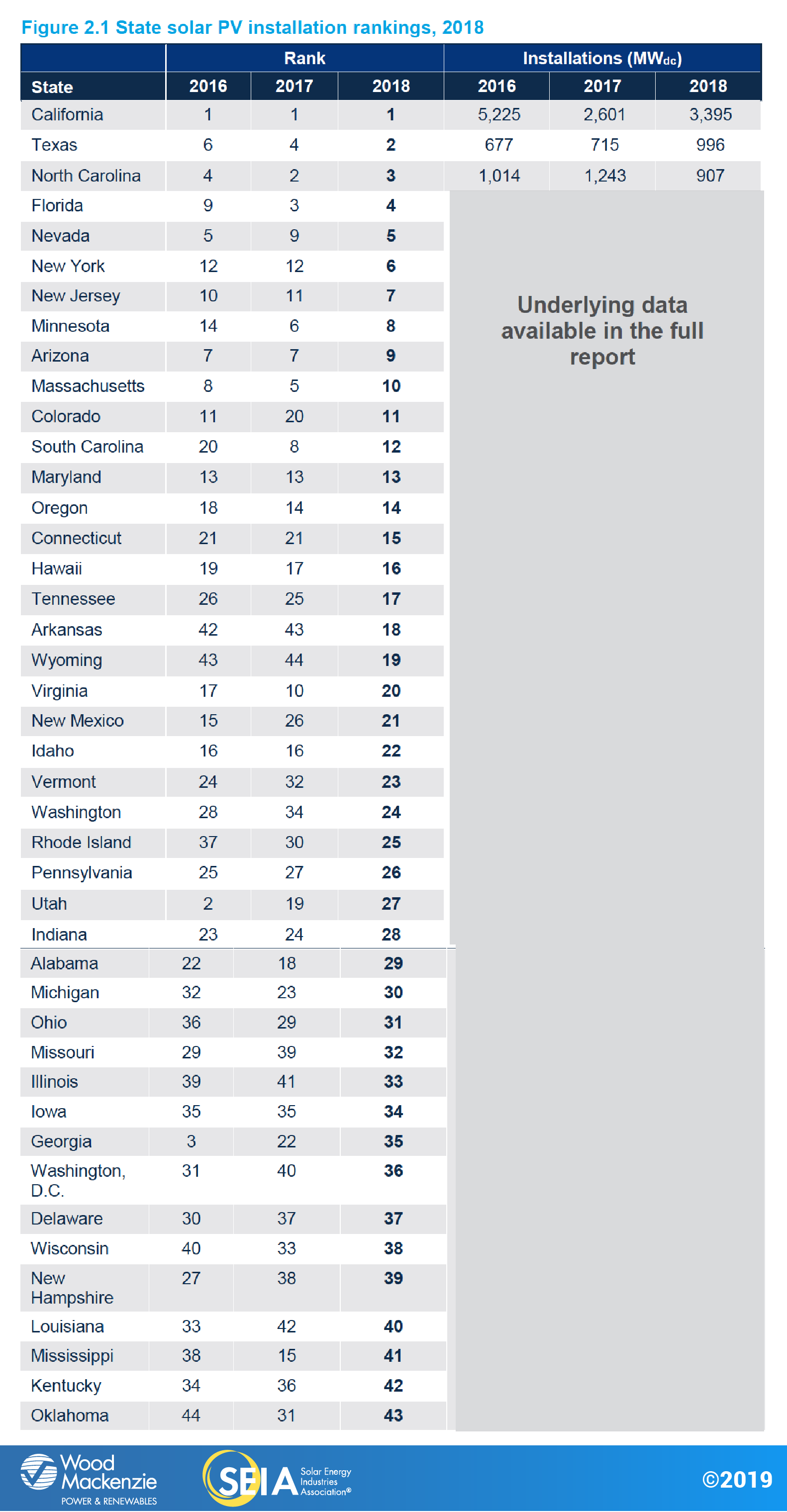
2.1. Market Segment Trends
2.1.1. Residential PV
- 2.4 GWdc installed in 2018
- Up 7% from 2017
Residential installation growth exceeded expectations for 2018, largely thanks to strong showings in California, Nevada and Florida.
Still, as major state markets continue to grow past early-adopter consumers, higher costs of customer acquisition will challenge the industry to innovate. Long-term growth prospects benefit from (among other factors): geographic diversification outside of legacy state markets, California’s new home solar mandate, new incentive programs such as Illinois’ Adjustable Block Program, and technological/business model innovation to improve product offerings into solar-plus-storage.
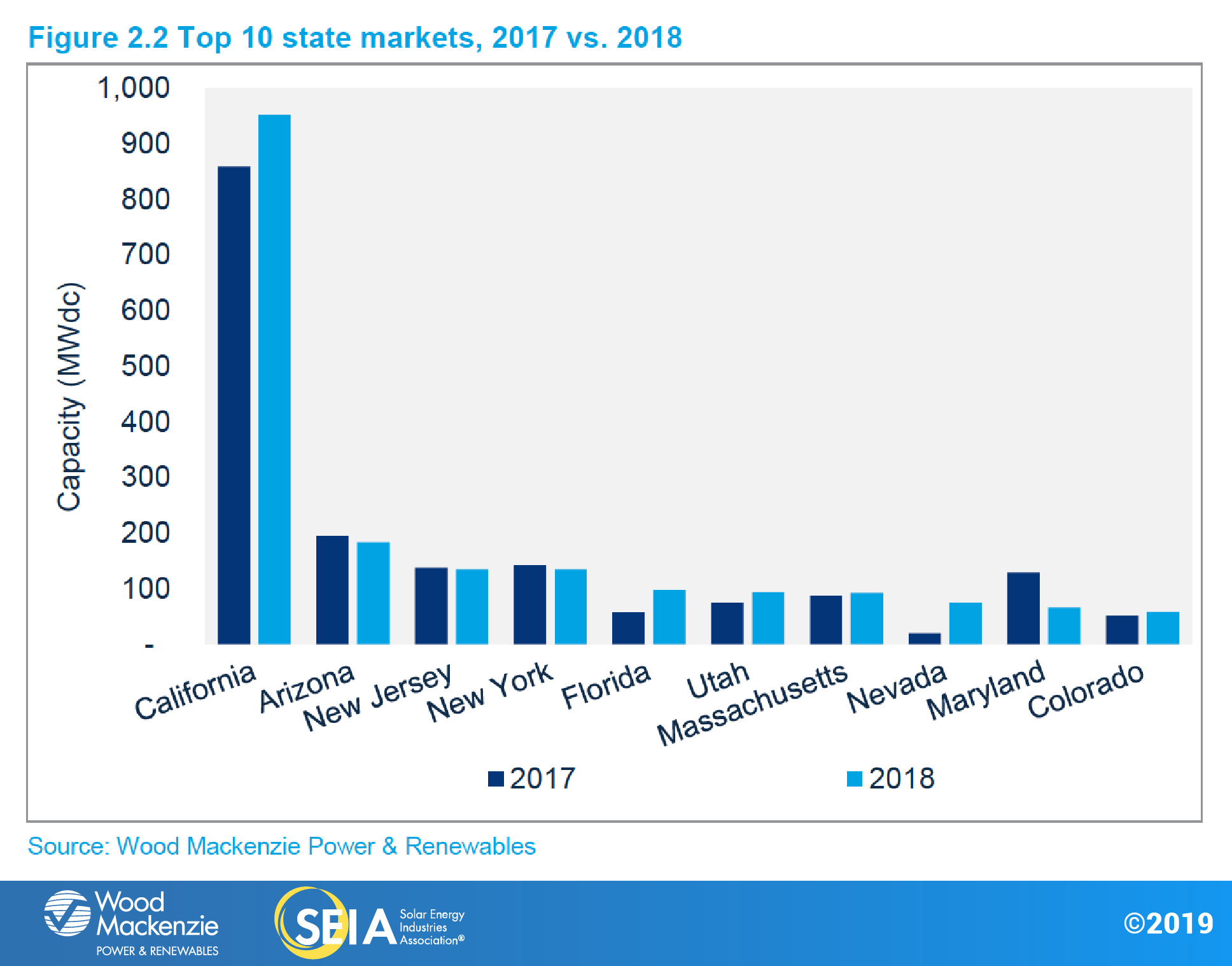
2.1.1. Non-residential PV
- 2.1 GWdc installed in 2018
- Down 8% from 2017
In 2018, the non-residential sector benefited from a large pipeline of projects grandfathered in under more favorable compensation policies in California and Massachusetts. California experienced commercial solar build-out in 2018, stemming from developers rushing to install projects to meet a (since-lifted) deadline to be grandfathered in under solar-friendly time-of-use rates.
Meanwhile, New York saw its largest year ever for commercial installations as the remaining pipeline of remote net-metering projects came online. However, the delayed opening of the SMART program in Massachusetts resulted in that state seeing 325 MW less capacity installed in 2018 than in the record-breaking 2017.
Additionally, the build-out of Xcel Energy’s robust community solar pipeline in Minnesota still accounts for a significant share of non-residential growth, with nearly 300 MWdc added in 2018. In total, Minnesota accounted for over 80% of the community solar build-out in 2018, while Massachusetts accounted for much of the remainder. Though the community solar market didn’t quite outpace 2017 capacity, last year marked the second consecutive year of over 500 MW of community solar installed.
2.1.3. Utility PV
- 6,163 MWdc installed 2018
- Down 3% from 2017
- Utility PV pipeline currently totals 22.9 GWdc
Utility PV continues to hold the largest share of annual installations in the U.S. solar market. In Q4 2018, 3.0 GWdc of utility PV capacity came online boosting the annual total to 6.2 GWdc in 2018. These additions represented 72% of total Q4 capacity and 58% of total U.S. capacity additions for the year. Lower-than-expected installation volumes in Q4 can be primarily attributed to two factors. The module tariffs set in January 2018 caused a handful of projects to reassess project timelines and push out target completed operation dates (CODs) from 2018 into 2019. Additionally, a handful of PURPA projects in the Carolinas have faced interconnection delays or have been outright canceled as utilities push back against standard rate agreements.
U.S. utility solar market procurement has grown considerably, largely set for years when tariffs have decreased. Many utilities like Tennessee Valley Authority, Georgia Power and Northern Indiana Public Service Co., have announced plans to add more utility PV to their generation portfolios.
With 13.2 GWdc of utility solar PPAs signed in 2018, the contracted pipeline peaked in Q3 2018 at 25.3 GWdc, the highest in the history of U.S. solar, and declined slightly in Q4 as project completion outpaced new PPAs signed.
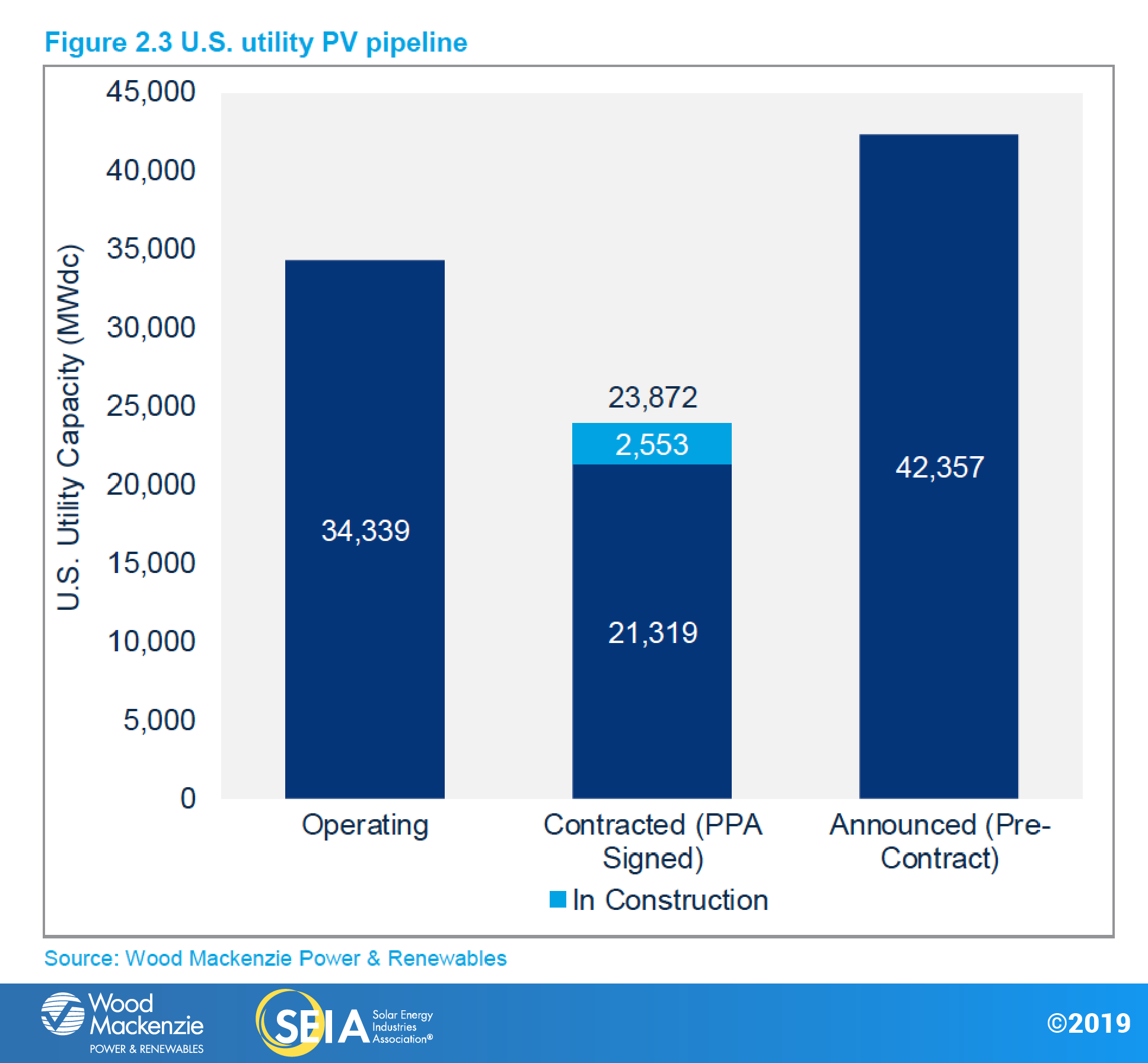
2.2. National solar PV system pricing
We employ a bottom-up modeling methodology to track and report national average PV system pricing for the major market segments. This methodology is based on tracked wholesale pricing of major solar components and data collected from interviews with major installers.
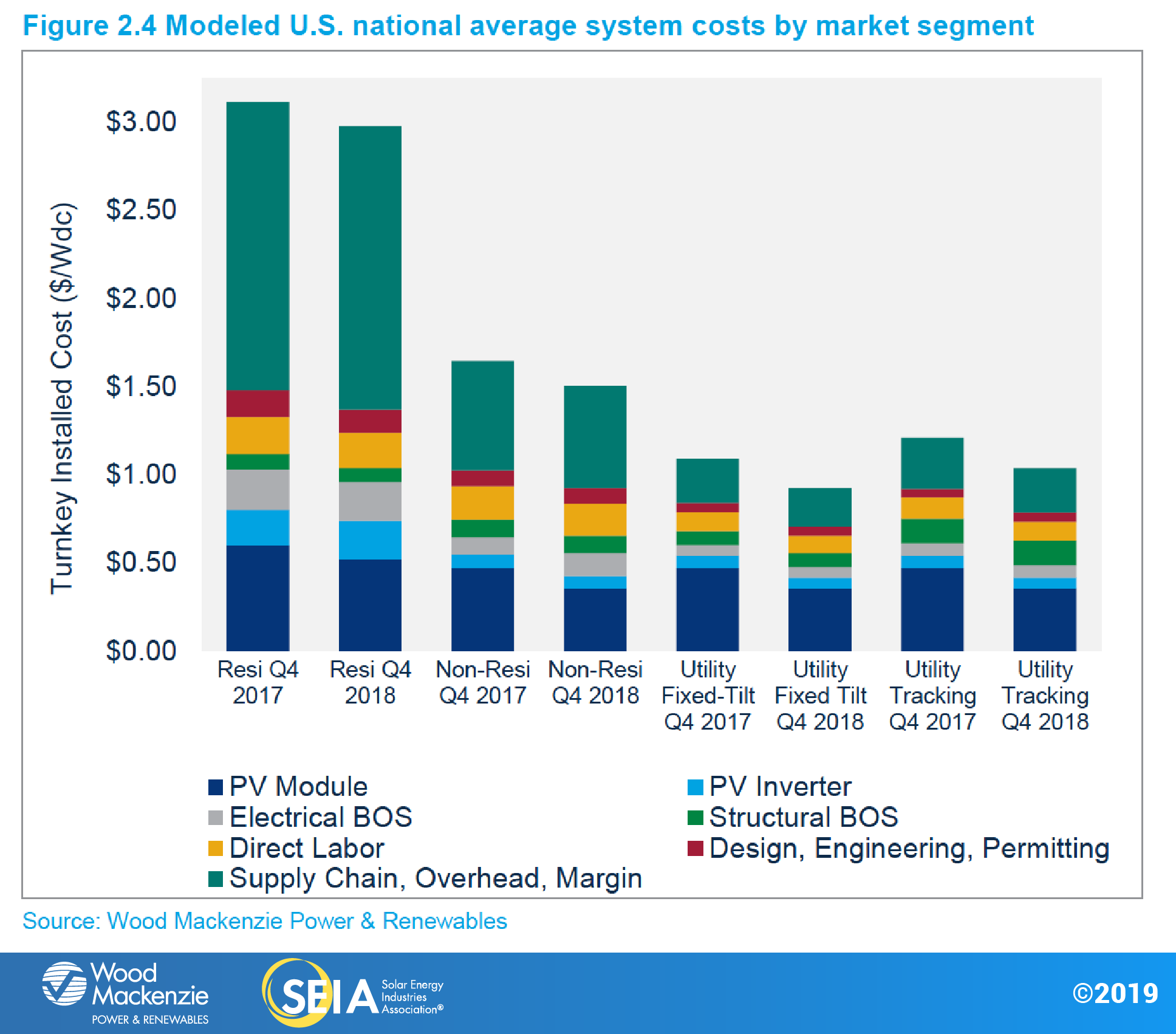
Note: Detailed information about national system prices by market segment and component is available in the full report.
In Q4 2018, system pricing fell in all market segments. Quarter-over-quarter, system pricing fell by 1.3%, 1.1%, 3.3% and 3.9% in the residential, non-residential, utility fixed-tilt and utility single-axis tracking markets, respectively. Prices across market segments are now all at historic lows despite tariffs on modules, inverters, aluminum and steel: $2.98/Wdc, $1.51/Wdc, $0.93/Wdc and $1.04/Wdc for residential, non-residential, utility fixed-tilt and utility single-axis tracking systems, respectively. Year-over-year system pricing fell by 4%, 8.5%, 15.1% and 14.4% in the residential, non-residential, utility fixed-tilt and utility single-axis tracking markets, respectively.
Price declines continue to be led by declining hardware costs, with much of the reduction coming in module pricing. Cuts to demand in China last June created global module over-supply conditions that led to lower module prices, somewhat mitigating the impacts of module tariffs in the U.S. The tariffs still, however, impose an opportunity cost on the U.S. industry, which cannot fully take advantage of pricing available to the rest of the world.
2.3. Component Pricing
- Polysilicon, wafer and cell price declines were severe. For polysilicon producers, the quarterly average price fell 21% quarter-over-quarter to $9.52/kg in Q4 2018. Polysilicon prices fell in response to buyer pressure, lower demand and increased inventory. Multi wafer and cell prices fell to $0.07/W and to $0.10/W, respectively. Price trends were driven by a massive drop in global demand and high inventory levels.
- Module prices in the U.S. fell in response to weak demand and competitive bidding as the global market entered into another oversupply cycle. Multi module prices averaged around $0.36/W in Q4 2018 and mono PERC prices averaged around $0.40/W.
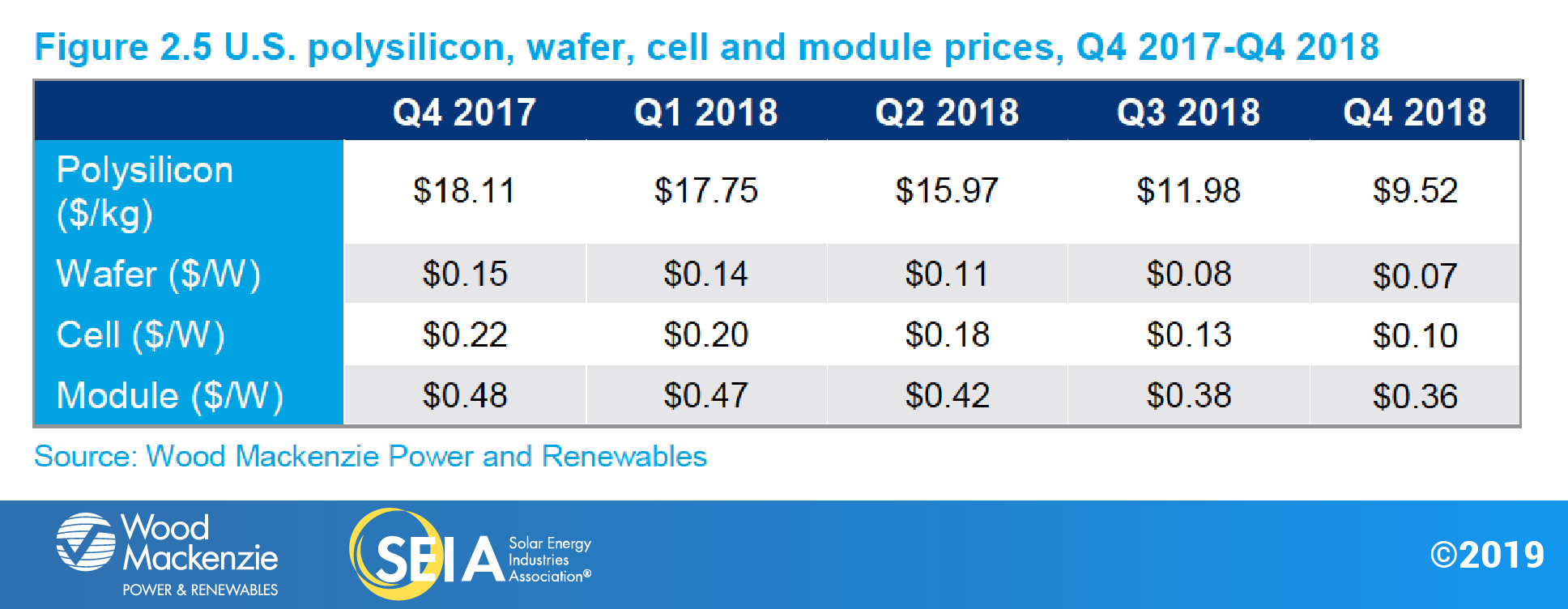
2.4. Market Outlook
After modest decline in 2018, the national solar PV market will resume growth in 2019-2020, primarily driven by continued growth in the residential segment and a rebound in the utility PV sector.
For utility PV, the downside to our 2018 forecasts benefits 2019 - the 2019 forecast has been increased from 7.2 GWdc to 7.8 GWdc as projects have pushed out target completion dates, and 2.1 GWdc of capacity is already under construction. The forecasts for 2020 and 2021 have increased to 10 and 10.4 GWdc, respectively. Of the projects announced in 2019, 68% have 2020 or 2021 target CODs, significantly boosting confidence in the near-term forecast. And we expect to see at least half of 2023 capacity additions leverage a 22% or higher ITC. Finally, growth will continue into 2024, driven by current utility IRPs for solar capacity along with the economic fundamentals of utility solar projects.
After examining the risks of advanced procurement, many project developers now seem more open to anchoring projects in 2019 to claim the 30% ITC and bringing them online in 2021 or later. Still, several developers have suggested they will assess each project on a case-by-case basis.
Commercial and industrial procurement is expected to remain a strong driver of utility solar over the next several years as the number of companies pledging to meet 100% renewables or zero-carbon targets increases. Renewable portfolio standards (RPSs) are also poised to see a resurgence as a driver of utility PV. Many of the newly elected governors are in states that have joined the U.S. Climate Alliance or campaigned on a pledge to join the Alliance and commit to the Paris Agreement in lieu of federal participation. Six of the governors have proposed increases to RPS targets, while three (Colorado, Nevada, and Illinois) have proposed 100% RPS mandates. This is in addition to California’s 100% RPS, Hawaii’s 100% RPS, and New York’s 50% RPS. If all states where elected governors campaigned on RPS increases were to achieve 50% RPS compliance by 2030, it could drive up to 37.0 GWdc of additional solar.
Wood Mackenzie’s utility PV five-year forecast has increased 2.3 GWdc since our last report as more projects are announced, utilities include more solar in long-term resource planning, and development is driven increasingly by C&I offtakers.
For residential PV, after seeing 7% growth in 2018, we expect flat to tempered growth in 2019, primarily due to major market maturation resulting in limited long-term growth opportunities in major Northeast markets. Meanwhile, the approval of a super off-peak rate in Southern California Edison territory – the second-largest utility in the nation for solar PV – takes effect in 2019, which severely limits the economic attractiveness of solar-only products. That said, growth resumes in 2020-2021 as the ITC step-down is expected to pull in demand in both legacy and emerging markets before declining in 2022. Growth resumes in 2023 and continues into 2024 based on economic fundamentals as the market adjusts to the post-ITC reality. In the long-term, residential capacity growth will be driven by California’s new home solar mandate – with upside potential from other states adopting similar mandates – a robust incentive program in Illinois, emerging markets like Texas and Florida becoming the new engines of retrofit growth, and the proliferation of solar-plus-storage.
Meanwhile, the non-residential PV market is on track for another down year as the segment acclimates to a reduced incentive environment across major state markets in 2019. However, this will be incrementally offset starting in 2020 as the next wave of states with robust community solar mandates – New York, Maryland, Illinois and New Jersey – begin to see the realization of those pipelines. Increasing solar-plus-storage viability will also begin to have an impact on non-residential demand.
By 2023, roughly 30% of non-residential PV will come from community solar, and ~20% will come from solar-plus-storage projects.
By 2020, 28 states in the U.S. are expected to have 100+ MWdc annual solar markets, with 25 of those states being home to more than 1 GWdc of operating solar PV. This compares to only two states with 100+ MWdc annual solar markets in 2010.
Forecast details by state (43 states plus Washington, D.C.) and market segment through 2024 are available in the full report.
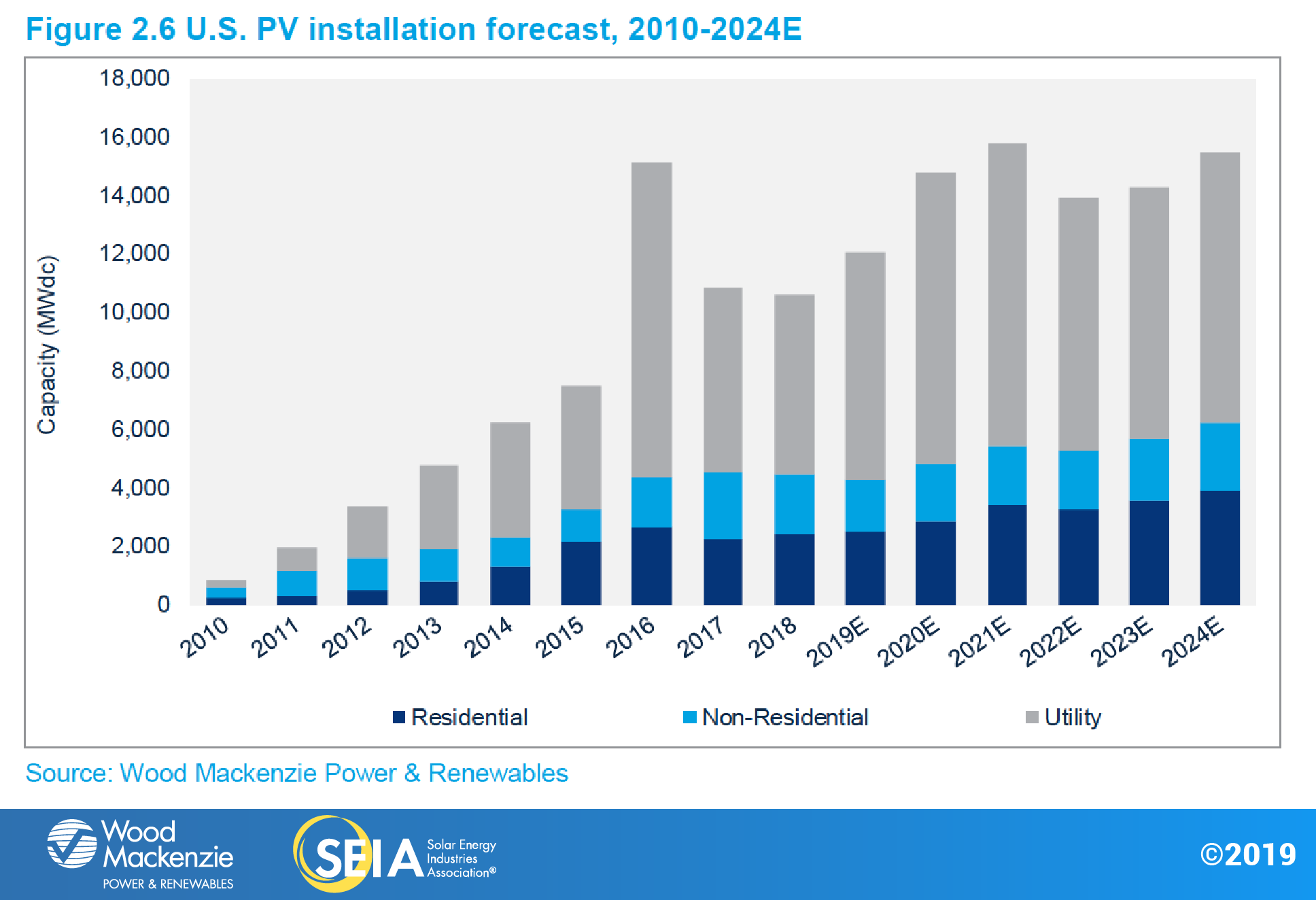
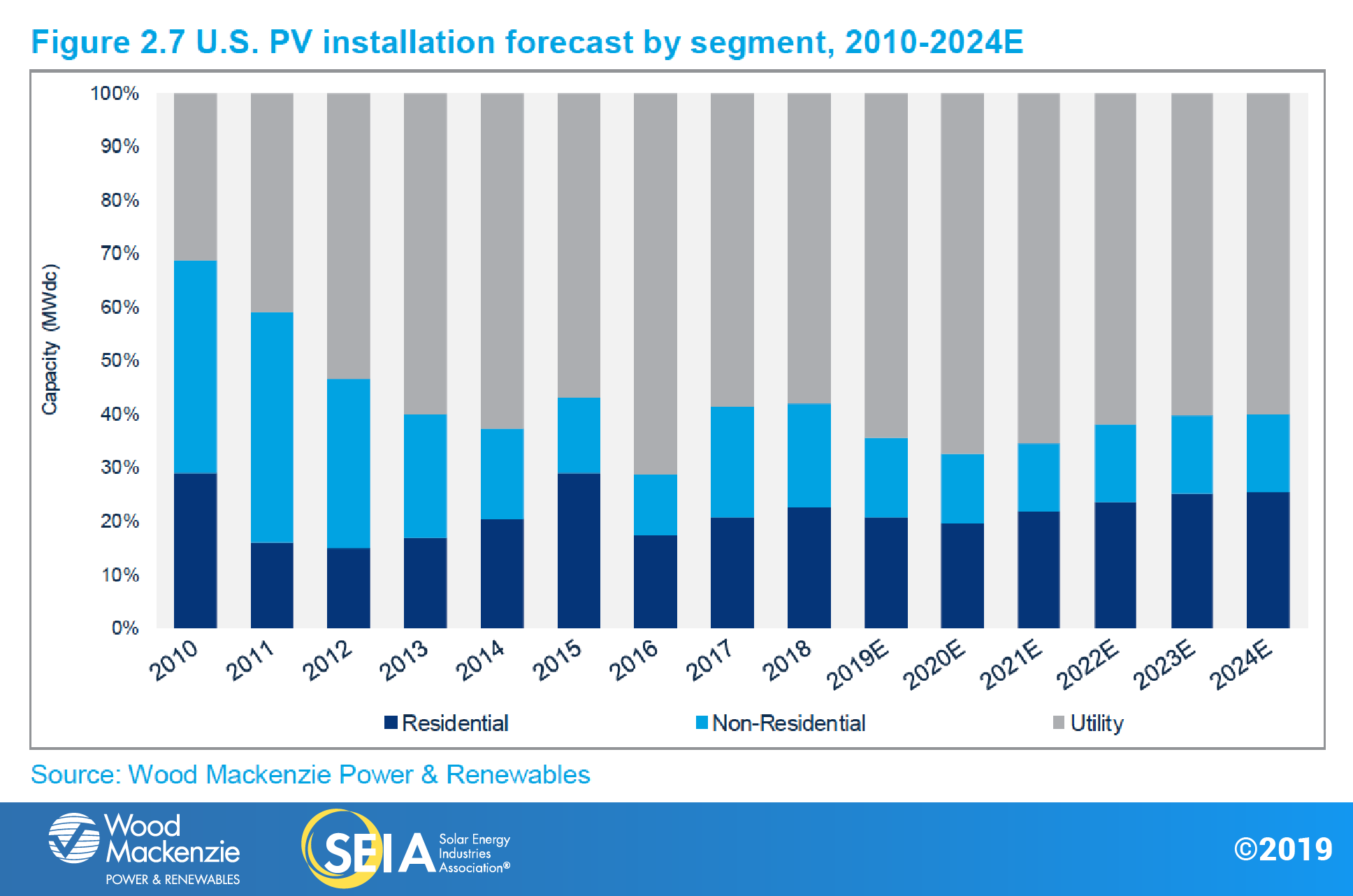
About the Report
U.S. solar market insight® is a quarterly publication of Wood Mackenzie Power & Renewables, Inc. d/b/a Greentech Media and the Solar Energy Industries Association (SEIA)®. Each quarter, we collect granular data on the U.S. solar market from nearly 200 utilities, state agencies, installers and manufacturers. This data provides the backbone of this U.S. solar market insight® report, in which we identify and analyze trends in U.S. solar demand, manufacturing and pricing by state and market segment. We also use this analysis to look forward and forecast demand over the next five years. All forecasts are from Wood Mackenzie, Limited; SEIA does not predict future pricing, bid terms, costs, deployment or supply.
- References, data, charts and analysis from this executive summary should be attributed to “Wood Mackenzie/SEIA U.S. solar market insight®.”
- Media inquiries should be directed to Wood Mackenzie’s PR team ([email protected]) and Morgan Lyons ([email protected]) at SEIA.
- All figures are sourced from Wood Mackenzie. For more detail on methodology and sources, click here.
- Wood Mackenzie Power and Renewables (WM P&R) partners with Clean Power Research to acquire project-level datasets from participating utilities that utilize the PowerClerk product platform. For more information on Clean Power Research’s product offerings, visit https://www.cleanpower.com/
Our coverage in these reports includes 43 individual states and Washington, D.C. However, the national totals reported include all 50 states, Washington, D.C. and Puerto Rico. The U.S. solar market insight® is offered in two versions – the Executive Summary and the Full Report. The Executive Summary is free, and the Full Report is available individually each quarter or as part of an annual subscription. Detailed data and forecasts by state are available in the Full Report. To find out more, click here.

Note on U.S. solar market insight report title: WM P&R and SEIA have changed the naming convention for the U.S. solar market insight report series. Starting with the report released in June 2016 onward, the report title will reference the quarter in which the report is released, as opposed to the most recent quarter in which installation figures are tracked. The exception will be our year in review publication, which covers the preceding year’s installation volumes despite being released during the first quarter of the current year.
About the Authors
Wood Mackenzie Power & Renewables | U.S. Research Team
Austin Perea, Senior Solar Analyst (lead author)
Colin Smith, Senior Solar Analyst
Michelle Davis, Senior Solar Analyst
Allison Mond, Senior Solar Analst
Benjamin Gallagher, Senior Solar Analyst
Solar Energy Industries Association | SEIA
Shawn Rumery, Director of Research
Aaron Holm, Data Engineer
Rachel Goldstein, Research Analyst
Justin Baca, Vice President of Markets & Research